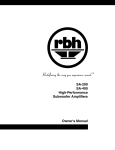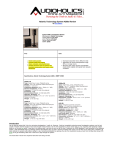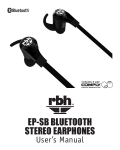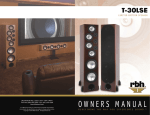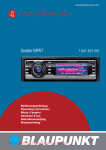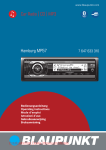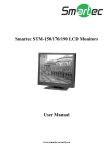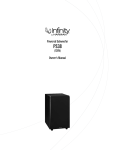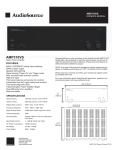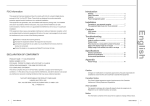Download S-8, S-10 AND S-12
Transcript
S-8, S-10 AND S-12 POWERED SUBWOOFER Owner ’s Manual Introduction Congratulations on your purchase of an RBH Sound powered subwoofer! Your subwoofer is the result of many years of research and development dedicated to producing powerful, accurate bass in home audio systems. This manual contains operating procedures and specifications. We recommend you thoroughly read through the material contained in this manual before connecting your subwoofer. This will ensure you have an understanding of how to setup and operate your subwoofer for optimum performance. Important Safety Instructions The lightning flash with the arrowhead symbol within an equilateral triangle, is intended to alert the user to the presence of un-insulated “dangerous voltage” within the product enclosure that my be of sufficient magnitude to constitute a risk of shock to persons. The exclamation point within an equilateral triangle is intended to alert the user to the presence of important operating and maintenance (servicing) instructions in the literature accompanying the product. When using your subwoofer, basic safety precautions should always be followed to reduce the risk of fire, electric shock, and injury. 1. Read and understand all instructions in the users manual before operating the powered subwoofer. 2. Retain this user manual for future reference. 3. Follow all warnings and instructions in this manual and any marked on the back of the powered subwoofer. 4. Never touch the woofers or push objects of any kind into the woofer. 5. The powered subwoofer should be connected to a power supply compatible with the power consumption requirements, see Specifications on page 6. 6. If mounting the powered subwoofer on a stand, the wall, or other device only do so as recommended by an authorized technician. 7. Place the powered subwoofer a safe distance from all heat sources such as radiators, stoves, or heaters. 8. Do not operate the powered subwoofer near water—for example, near a bathtub, kitchen sink or in a wet basement; or a swimming pool. 9. Power supply cords should be routed so they are not likely to be walked on or pinched by items placed upon or against them. 10. Any service or repair required on the powered subwoofer must be performed by qualified, authorized technician. 1 S-8, S-10 and S-12 Powered Subwoofer S-8 Subwoofer S-10 Subwoofer S-12 Subwoofer Break In Period Allow several hours of listening time to adequately break-in the subwoofer. As the subwoofer breaks-in, the driver suspensions will loosen. The result of break-in will be an increase in low frequency response, improved definition, and increased clarity and detail. Care and Cleaning To maintain your subwoofer’s appearance, we recommend wiping it down with a clean damp soft cloth. To clean dust from the grille cloth, use a vacuum with a brush attachment. 2 Features A powered subwoofer is a must-have component for any home theater or audio system. The performance of your subwoofer can greatly affect the overall performance of your system. Without a powered subwoofer, the deep bass on your music CDs and special effects on DVDs may not be heard and/or felt. Think of a subwoofer as a vital component that adds excitement to your theater or music experience. The powered subwoofer has its own source of amplification (as opposed to passive, non-amplified subwoofers which require an additional power amplifier). Subwoofers can add considerable low-frequency, deep bass performance to any home theater or audio system. At the heart of the powered subwoofer is an aluminum cone driver. The driver material produces enhanced bass definition and accuracy. A powerful magnet, enhanced suspension and heavy duty voice coil give the driver elevated performance allowing high output capability and accurate dynamic reproduction. The powered subwoofer incorporates a class D amplifier with switching power supply technology, resulting in higher power output, improved bass performance and maximum energy efficiency. Variable crossover, adjustable phase control and auto on/off are also used for convenience and easy integration with other speakers. Audio can be supplied to the subwoofer by either interconnect (LFE/line level inputs). Cabinets are constructed from medium density fiberboard because of its inert properties. The thickness of the front baffle also prevents excess acoustic radiation. Sophisticated computer modeling and measurement techniques are used extensively in the powered subwoofer design process. 3 Room Setup Suggestions In order to obtain the best possible sound from your subwoofer and speaker system, it is important to determine where the subwoofer and speakers will sound best in your listening room. Room reflections from the floor, ceiling and side walls influence the balance, imaging and overall sonic quality at the listening position. Experiment with placement to determine which location offers the best overall sound. As a general guide, use the room layout diagram and the following descriptions when setting up a home theater system. The subwoofer and speakers shown in the diagram may not always be applicable to your system. Front Main Speakers As a starting point, place your left and right tower speakers at least 15 inches from the wall and 7-feet apart from each other. The distance from the listening position to each speaker should be close to the distance that separates the two main speakers. Angling the speakers inward towards the listening position may give a more spacious and realistic sound stage. Center Channel Speaker The center channel speaker should be placed in the center between both left and right main speakers. Often this positioning dictates placing the speaker either directly above or below a television monitor. The center channel speaker may be placed in a horizontal (lying down) or vertical (standing) position. Rear Surround Speakers The 2-way bookshelf speakers may be placed either above, behind or to the sides of the listening position. The listening position should be centered between the surround speakers. For best performance you may want to experiment with angling the surround speakers either towards or away from the listening position. Subwoofer In order to obtain the best possible sound from your subwoofer, it is important to determine where the subwoofer will sound best in your listening room. Sound reflections from the floor, ceiling and side walls influence the balance, imaging and overall sonic quality at the listening position. Experiment with subwoofer placement to determine which location offers the best overall sound. Placement of the subwoofer will largely determine quality, quantity and extension of the bass frequencies within your listening room. Bass frequencies are reinforced by close room boundaries. Placing the subwoofer in a corner will make the subwoofer sound louder and boost the very lowest frequencies. Placing the subwoofer away from walls will provide the least reinforcement, making the bass sound subjectively thinner than if the woofer were closer to a wall. Good results can usually be obtained by placing a subwoofer along a wall 1-3 feet from a corner. Experiment with placement of the subwoofer and the subamplifier controls to achieve the proper bass balance. 4 Room Setup Suggestions (continued) 5 Subwoofer Amplifier Controls and Setup IMPORTANT NOTICE REGARDING BASS MANAGEMENT: It is important the signal being sent to the subwoofer be a non-boosted or “flat” signal. Check the settings on your receiver or processor to make sure any “bass boost”, “super bass” or “loudness” is set to Off. In most cases a home theater receiver or processor will determine the crossover frequency through bass management settings. In this configuration, connect the receiver or processor to the LFE (Low Frequency Effect). Your subwoofer will now reproduce the bass frequencies as they were originally recorded. Use the subwoofer level control and the individual bass management control within the receiver or processor to adjust the subwoofers’ volume if necessary. Once set, the volume controls should not need to be altered as the subwoofers’ volume will track with the master volume control of your receiver or processor. Use Line Input only if bypassing your receivers internal processing to deliver a full signal to your subwoofer which is then managed by the subwoofer’s frequency and volume control. This section describes the functions and/or use for each of the amplifier controls located on the back of the subwoofer. Refer to the diagrams on the pages 8 and 9. 1. Voltage Selector Switch: Before connecting the amplifier to any power source make sure the AC Voltage Selector is set to either 110V or 220V to match the power voltage in your area. WARNING! If the voltage setting does not match the AC power supplied, damage to the Subwoofer Amplifier may result. 2. Volume/Gain Control: The volume/level control should be at the minimum setting (all the way counter-clockwise) before plugging the subwoofer into an AC wall socket. Once plugged in, turn the level control up one quarter of a turn (9 o’clock position) for an initial setting. The level control may be adjusted while playing to match the subwoofer level with the rest of the system. IMPORTANT! The volume control should be at the minimum setting (all the way counter-clockwise) before plugging the subwoofer into an AC wall socket. 3. Crossover Frequency Control: The variable crossover frequency control allows you to set the low-pass crossover point of the subwoofer anywhere from 40-150 Hz. If using this input experiment with setting the crossover frequency control at highest setting initially. Increasing the crossover frequency will allow more mid-bass output from the subwoofer. Decreasing the frequency will allow only deeper bass from the subwoofer. NOTE: Read the Important Notice regarding bass management above. 6 Subwoofer Amplifier Controls and Setup (continued) 4. Auto Signal Tracking: The subwoofer amplifier uses “smart” signal tracking circuitry. Once the power cord is plugged in and the switch set to auto, the amplifier automatically turns on when a signal is detected at the preamplifier or high level inputs and turns off when no signal has been detected for 15 minutes. 5. Phase Control: This control changes the phase of the subwoofer. Changing the phase will change the way the subwoofer and main speakers interact with each other at the crossover frequency. Varying the phase position may result in more or less mid bass depending on the phasing between the main speakers and the subwoofer. 6. Line Inputs: Line level input should only be used if no subwoofer crossover is being utilized through the receivers bass management. 7. LFE In: Line level input is used to connect to most receivers or processors. The “LFE” output of receiver and may be called “subout”. 8. Fuse Access: This is the power fuse access. WARNING! In the event the fuse must be replaced, the replacement fuse must match exactly the original fuse value. If the replacement fuse is not of the same value, damage to the Subwoofer Amplifier may result. 7 Subwoofer Amplifier Controls and Setup (continued) S-8 and S-10 Subwoofer Amplifier Diagram. 8 Subwoofer Amplifier Controls and Setup (continued) S-12 Subwoofer Amplifier Diagram. 9 Specifications Model S-8 S-10 S-12 Driver: 8” (203mm) Aluminum Cone Subwoofer 10” (254mm) Aluminum Cone Subwoofer 12” (305mm) Aluminum Cone Subwoofer Amplifier Type: Class D Class D Class D Voltage: 110 and 220 110 and 220 110 and 220 Power Handling: 150 Watts 150 Watts 250 Watts Crossover Frequencies: 40-150Hz (variable) 40-150Hz (variable) 40-150Hz (variable) Frequencies Response: 32Hz-150Hz (variable) 32Hz-150Hz (variable) 32Hz-150Hz (variable) LFE Input: Yes Yes Yes LFE Output: No No Yes Line Level Input: Yes Yes Yes Speaker Level Inputs: No No No Speaker Level Outputs: No No No Phase Control: Yes (Auto On/Off) Yes (Auto On/Off) Yes (Auto On/Off) Cabinet/Color: Medium Density Fiberboard (MDF)/Black Medium Density Fiberboard (MDF)/Black Medium Density Fiberboard (MDF)/Black Grille: Black Cloth Black Cloth Black Cloth Dimensions: (includes feet and grille) 11” (279mm ) W 12½” (318mm ) H 12¾” (324mm) D 13” (330mm ) W 15½” (394mm ) H 16½” (419mm) D 15¾” (400mm ) W 17¼” (438mm) H 18” (457mm) D Weight: 19.25 lbs. (8.73 kg.) 33 lbs. (14.97 kg.) 42 lbs. (19.05 kg.) Warranty: 5 Years/1 Year* 5 Years/1 Year* 5 Years/1 Year* * Warranty period: 5 years on the cabinet and woofers, and 1 year on the amplifier 10 CAUTION! Before replacing the fuse, disconnect Situation: Probable Cause: Solution: No sound from subwoofer(s) Amplifier is not connected to constant power outlet. Make certain the amplifier is plugged into an unswitched A.C. power outlet. Amplifier is not receiving an audio signal from receiver or processor Make certain there is an audio signal from receiver or processor and audio connections resemble those in the connections section of this manual. Amplifier fuse might be blown. Replace fuse (if fuse is not readily accessible, consult your authorized dealer). The + and - polarity of the subwoofer wire might be reversed on the subwoofer. Check the entire system for proper polarity. Experiment with the phase switch. Crossover frequency not adjusted correctly. Adjust crossover frequency by turning the crossover frequency control clockwise until desired sound is obtained. L/R line level input is connected instead of the LFE line level input. If bass management is enabled on receiver or processor make sure to use the LFE line level input. (See amplifier controls and setup on the previous page.) Performance is less than expected 11 Warranty Your RBH Sound Powered Subwoofer is covered by a limited warranty against defects in materials and workmanship for a period of 5 years on the cabinet and woofers, and 1 year on the amplifier from the original date of purchase. This warranty is provided by the authorized RBH Sound dealer where the subwoofer was purchased. Warranty repair will be performed only when your purchase receipt is presented as proof of ownership and date of purchase. Defective parts will be repaired or replaced without charge by your dealer’s store or by RBH Sound authorized locations to service RBH Sound products. Charges for unauthorized service and transportation cost are not reimbursable under this warranty. This warranty becomes void if the product has been damaged by alteration, misuse or neglect. RBH Sound assumes no liability for property damage or any other incidental or consequential damage whatsoever which may result from the failure of this product. Any and all warranties of merchantability and fitness implied by law are limited to the duration of this express warranty. Some states do not allow limitations on how long an implied warranty lasts, so the above limitations may not apply to you. Some states do not allow the exclusion or limitation of 12 TM Redefining The Way You Experience Sound. 382 Marshall Way, Layton, Utah • USA • 84041 Toll Free: (800) 543-2205 • Fax: (801) 543-3300 www.rbhsound.com It is RBH Sound policy to continuously incorporate improvements into products; all specifications are subject to change without notice. Copyright © 2013 RBH Sound. All Rights Reserved. 02012013


















